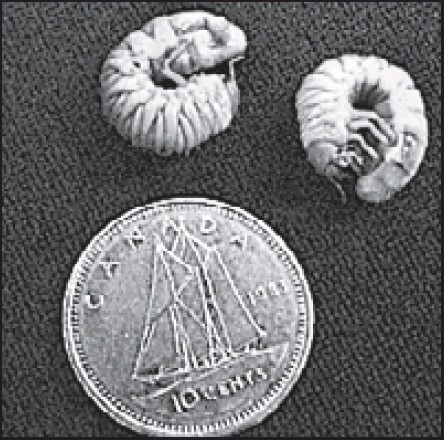Wendy McLellan
Province

European chafer grubs, shown here beside a dime, are wreaking havoc around the Lower Mainland. BOB COSTELLO – FOR THE PROVINCE
The first sign of invasion is usually the clumps of grass pulled out by the roots and flung all over the yard.
A look under a bit of the remaining lawn will probably confirm it: fat, curled-up, white grubs just under the turf are providing a handy buffet for every raccoon, skunk and crow in the neighbourhood.
Coquitlam is the latest Lower Mainland community to suffer an invasion of European chafer beetles, and pest-control experts would like to stop the bugs before they spread any further. It seems like an impossible dream.
“They are so devastating in the first few years, they wreak havoc,” said Tracy Hueppelsheuser, an entomologist with the province’s Plant Health Unit in Abbotsford.
“If you don’t deal with it, you just won’t have any lawn.”
While the chafer beetles don’t cause any harm, they lay their eggs in lawns and the larvae feed on the roots.
In spring, when the grubs migrate close to the soil surface, they become a banquet for bug-loving wildlife that easily tear out the damaged grass.
The first Lower Mainland community to battle the beetles was New Westminster in 2001.
From there, the bugs spread to Burnaby and are steadily marching west and south through Vancouver. Coquitlam now has its first brush with the bugs.
“They’re just on the border of Coquitlam, and they have made it as far west as Oak Street in Vancouver,” said Ian Wraight, owner of the Vancouver lawn-care franchise for Nutri-Lawn.
“Some people’s lawns are so devastated they pretty much have nothing left. If you’re lucky, you will have a little damage that can be repaired. But sometimes all you can do is replace the lawn and that can be a major cost for the homeowner.”
So far, the beetles haven’t made it across the Fraser River into the Valley or on to the North Shore.
While the beetles can fly short distances before laying their eggs, the best way to control them is to keep a healthy lawn and not move fill from infested communities into new areas.
How to kill the invader
The best defence against European chafer beetles is a healthy lawn. Beetles prefer stressed turf with dry spots when lay their eggs in early July, so keep your lawn watered and a little long.
If you are in an infested neighbourhood, apply a predatory nematode to attack the eggs or use chemical insecticides. For more info, go to www.agf.gov.bc.ca/cropprot/chafer.htm or your municipality’s website.
© Copyright (c) The Province
